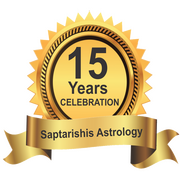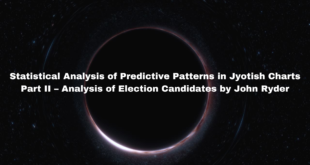Related Articles
Jaimini is predominantly practiced in the Andhra Pradesh area of India, mostly as a somewhat secret tradition, but its governing principles are also discussed in detail in the encyclopedic compendium of astrological techniques, the Brihat Parasara Hora Sastra.
The Jaimini factors are not referred to specifically as Jaimini indicators in BPHS. However, when one reads P. S. Sastri’s translation of the Jaimini Sutras, or either of Mr. Rao’s texts on Jaimini Astrology, one realizes that these principles in BPHS are, in fact, Jaimini principles.
There are other Jaimini texts which have emerged over the years (including The Jaimini Upadesa Sutras written by Sanjay Rath, and published this year).
Mr. Rao’s texts go the furthest in explaining how the Jaimini dasa systems work, and are, in my opinion, the clearest exposition of Jaimini principles available in the West and I would recommend these for any one who wishes to build a foundation in and explore the basic structure of Jaimini astrology in greater depth.
The defining characteristics of Jaimini Astrology are as follows:
1) Mahadasas. Jaimini uses rasi mahadasas (sign mahadasas), in contrast to the graha (planetary) mahadasas used in Parasari astrology.
2) Special Aspects. In Jaimini astrology, signs, not planets, cast aspects in Jaimini. Fixed signs aspect cardinal signs and cardinal signs aspect fixed signs (except for adjacent signs). Mutable signs aspect each other. The following is the way in which the signs aspect each other.
a. Aries aspects Leo, Scorpio, and Aquarius
b. Taurus aspects Cancer, Libra, and Capricorn
c. Cancer aspects Scorpio, Aquarius and Taurus
d. Leo aspects Libra, Capricorn, and Aries
e. Libra aspects Aquarius, Taurus, and Leo
f. Scorpio aspects Capricorn, Aries, and Cancer
g. Capricorn aspects Taurus, Leo, and Scorpio
h. Aquarius aspects Aries, Cancer, and Libra
i. Gemini, Virgo, Sagittarius and Pisces aspect each other.
2) The use of padas. Padas are indicators in the signs. The best way to explain a pada is to illustrate it. Suppose we are looking for the marriage pada in a chart. The seventh house is the marriage house in a standard chart. Let us assume we have a Libra ascendant. Aries is the seventh house in this chart. The ruler of the seventh house is therefore Mars. Then let us assume that the Graha Mars is in the sign Capricorn. This sign is ten signs away from Aries. We then count ten signs from Capricorn to get the pada for marriage matters. Thus, the sign Libra is the marriage indicator for this chart. Issues connected with marriage (and partnerships in general) will be reach fruition during the mahadasa or bhuktis of Libra.
3) The extensive use of karakas. There are karakas in Parasara astrology, but these are based on certain natural karakas of the planets. For example, Venus is the natural karaka for marriage and Mars is the karaka for brothers. However, in Jaimini astrology, the Karakas can be any of the planets. I choose to follow Mr. Rao in excluding the North and South Lunar Node — Rahu and Ketu — as Jaimini karakas for most purposes. There are seven karakas which are judged in terms of the planet which is highest in degree to that which is lowest in degree, regardless of sign placement. The karakas are, in descending order, the atma karaka (the indicator of self), the amatya karaka (the indicator of career); the bhatri karaka (the indicator of siblings and father); the matri karaka (the indicator of mother and education); the putri (some say Pitri) karaka (the indicator of children, intelligence and creativity; some sources say this is the Father indicator); the gnati karaka (the indicator of strife, disease, and spiritual sadhana); and the stri or dara karaka, the indicator of marriage (and partnerships in general). These karakas are of extreme importance in judging a chart, especially in terms of career and spiritual potential, as indicated in both the Brihat Parasara Hora Sastra and the Jaimini Sutram.
SEQUENCE OF MAHADASAS
PART II
The following are the major differences between Jaimini and “standard” Parasara astrology:
1) The use of sign mahadasas (Chara, Sthira and Shoola dasas are the best known, but there are approximately 44 mahadasas used in Jaimini astrology);
2) The use of padas. Padas are indicators in the signs. The best way to explain a pada is to illustrate it. Suppose we are looking for the marriage pada in a chart. The seventh house is the marriage house in a standard chart. Let us assume we have a Libra ascendant. Aries is the seventh house in this chart. The ruler of the seventh house is therefore Mars. Then let us assume that the Graha Mars is in the sign Capricorn. This sign is ten signs away from Aries. We then count ten signs from Capricorn to get the pada for marriage matters. Thus, the sign Libra is the marriage indicator for this chart. Issues connected with marriage (and partnerships in general) will be reach fruition during the mahadasa or bhuktis of Libra.
3) The extensive use of karakas. There are karakas in Parasara astrology, but these are based on certain “natural” karakas of the planets. For example, Venus is the natural karaka for marriage and Mars is the karaka for brothers. However, in Jaimini astrology, the Karakas can be any of the planets. (I choose to follow Mr. Rao in choosing to exclude the North and South Lunar Node — Rahu and Ketu — as Jaimini karakas for most purposes. There are seven karakas which are judged in terms of the planet which is highest in degree to that which is lowest in degree, regardless of sign placement. The karakas are, in descending order, the atma karaka (the indicator of self), the amatya karaka (the indicator of career); the bhatri karaka (the indicator of siblings and father); the matri karaka (the indicator of mother and education); the putri karaka (the indicator of children, intelligence and creativity); the gnati karaka (the indicator of strife, disease, and spiritual sadhana); and the stri or dara karaka, the indicator of marriage (and partnerships in general). These karakas are of extreme importance in judging a chart, especially in terms of career potential and, especially, for judging spiritual potential, as indicated in both the Brihat Parasara Hora Sastra and the Jaimini Sutram. Also, although this stance is not universally endorsed, it has also been my experience that the Jaimini karakas work especially well when we analyze the planetary mahadasas and the maturity of planets. I also believe that the natural Parasara planetary karakas also exert their influence on the Jaimini karakas. Vedic Astrologer Robert Koch has discussed the way in which Jaimini indicators can be used in Parasari settings in his excellent contribution to Richard Houck’s compilation Vedic Astrology Lessons and the text Jataka Tattwa describes methods for using the two systems in tandem.
We will limit this discussion to the use of the Jaimini Chara dasas, padas, and Jaimini Karakas as spiritual determinants in a chart. The major points that we will look at are some of the spiritual indicators in Jaimini which are mentioned in the Brihat Parasara Hora Sastra and in the Jaimini Sutram.
There is another part of Jaimini Astrology which must be accounted for in analyzing charts for spiritual potential. The atma karaka (planet in the highest degree in the chart) will fall in a certain sign in the Navamsa (harmonic ninth) chart. This sign in the Navamsa in which the Atma Karaka falls is extremely important. According to one school of thought, this sign assumes a special status called the Karakamsa. K. N. Rao has made a special study of this topic and feels that this sign should be moved to the natal chart, and there it becomes the Karakamsa. The Navamsa position of the atmakaraka then becomes an entity called a Swamsa chart. This is not so insignificant a matter as it seems at first. The BPHS and Jaimini Sutram indicate that certain planets in certain positions from the Karakamsa will produce specific spiritual effects and affiliations, and the placement of planets from the Swamsa and the Karakamsa will often differ dramatically, so certain spiritual combinations which show in the Navamsa chart will not appear in the natal chart, and vice versa. For the analysis of spiritual potential in the chart, a choice must be made. We do need to make a choice, if only to determine a starting place.
Before my encounters with Mr. Rao, I had relatively good results in delineating spiritual preferences when using the Navamsa chart as the location of the Karakamsa. However, closer examination of certain charts of individuals who had never been known for spiritual tendencies showed that certain indications which were supposed to follow by the placement of the Atma Karaka in certain signs made me reevaluate my position, and led me closer to the position adopted by Mr. Rao. The placement of the Atma Karaka in the sign Pisces, for example, did not necessarily “grant final emancipation” or produce spiritual individuals. The technique used by Mr. Rao seems to work more consistently.
Let’s examine the chart of one of the best known spiritual teachers of the twentieth century, Paramahamsa Yogananda. Yogananda introduced the West to the discipline of Kriya Yoga, a yogic science passed on by the 1,000 year old emanation of Shiva known as Babaji. Yogananda was clearly a very famous spiritual individual, lecturing to thousands and establishing one of the most enduring spiritual groups of the twentieth century, the Self-Realization Fellowship. Even the fact that there are at least a half dozen disparate and unaffiliated Kriya Yoga Organizations in the United States (The Ananda Church in California and the Temple of Kriya Yoga in Chicago are examples of the diversity of Kriya Yoga practiced in the United States). He is also well known for not showing any visible signs of decay for twenty days after his death at Forest Lawn Cemetery. If we examine his chart, we see that Yogananda’s atma karaka planet is Venus (Shukra) and that this planet is located in the fourth house, one of the three moksha (liberation) houses, in Scorpio (Vrischika) one of the three moksha signs (Scorpio, Cancer and Pisces are considered the moksha signs, perhaps because water signs are considered signs of dissolution or merging with the infinite.).
If we look at the padas of the various houses, the fourth house pada (the indicator of where the heart is in a natal chart) is located in the twelfth house (Cancer), an indicator that this individual’s emotions are connected with renunciation, a necessary attribute for a sanyasin, which Yogananda was). Also, if we look carefully at the fourth house, we see several auspicious upagrahas in the fourth house (Upagrahas are points in space and are calculated for you in most of the newer Vedic Astrology programs–they corroborate but normally do not change the overall interpretation of the chart). the Pranapada, Kala , Indrachapa (the child of Shukra) and Upaketu are all in the fourth house, Upaketu giving great qualities of renunciation, but the presence of Indrachapa giving the blessings of the great teacher Shukra, and Shukra himself blessing this individual with divine bliss through deep control of Kundalini energy — also known as Kriya.
In the Brihat Parasara Hora Sastra, the placement of Upaketu in the fourth house makes the native “charming, very virtuous, gentle, interested in Vedas, and … always happy”. The placement of Indra Chapa in the fourth makes the native “happy, endowed with quadrupeds, wealth, grains, etc. be honored by the king and be devoid of sickness”. It was known that Yogananda was able to access large amounts of money and nice cars “Quadrupeds”) when he needed to, and he also met with President Calvin Coolidge, among other world leaders. Kala, an inauspicious upagraha which acts like Rahu is also in the fourth house, which indicates his separation from his parents, his lack of interest in academic disciplines, and the early death of his mother.
The placement of Rahu in the ninth gives fame, but also gives a famous Guru. This was certainly the case of Sri Yukteswar, who is probably the one of the most famous Indian gurus who never left India (including Paramahamsa Ramakrishna and Swami Sivananda). Yogananda’s extreme attachment to his Guru is probably due to the pada of the ninth house being placed in the seventh house. The Kriya Yoga tradition calls for an extremely strong attachment between disciple and teacher, and Yogananda never wished to marry, perhaps because he was already emotionally “married” to his teacher. Remember — to determine a pada, count from the house being evaluated to the house in which the ruler of that house sits, then count from that house the same number of houses as the ruler of the house. In this case Mars is the ruler of the sign in which Rahu sits (Aries). Mars is in Pisces in this chart, and is located twelve signs away from Aries. We then count from Pisces to twelve signs away — this leads to the seventh house sign Aquarius, which the becomes the indicator of the Guru, or spiritual teacher. In 1922, Yogananda entered an Aquarius mahadasa (Jaimini uses sign mahadasas rather than planetary mahadasas). This was the time that he went to the United States at the bequest of his Guru. We can trace other events, such as his great fame in the United States after he entered his Aries Mahadasa (with Rahu in Aries, fame was certainly assured).
Shukra, the Atma Karaka planet in Yogananda’s chart, is located in the sign Aquarius in the Navamsa, so Aquarius is the Karakamsa house in the natal chart. So we can start to assess the indicators from either the Rasi chart and the Navamsa chart. Interestingly BPHS does say that if Venus is in the Karakamsa one gets initiated in a religious order. This holds true when we look at Yogananda’s chart from the Navamsa chart, but not from the Rasi chart.
Yogananda’s amatyakaraka (career) planet was Jupiter (also known as Guru in Sanskrit) — it is then fitting and appropriate that during his Pisces mahadasa he was mostly involved in teaching Kriya Yoga. The placement of Jupiter with Mars emphasizes that he would teach a yoga path which emphasized rapid development. Kriya is really a “Mars” type of yoga in that it calls for extreme self control and the development of willpower as a means to liberation. This is corroborated by his chart in that the eighth house is really a “kundalini” or “kriya” house, because any yoga which involves control of sexual energy through willpower requires a strong eighth house. This strong eighth house also probably gave Yogananda the willpower to preserve his physical body after his “mahasamadhi”.
The chart of the Dalai Lama also gives evidence of the way that the Jaimini karakas work in a spiritual chart. His atmakaraka planet is Mars — this is common among individuals who practice intense meditative practices, and I have read several accounts that the Dalai Lama spends at least two hours a day in meditation even while keeping an active travel agenda. Mars is located in the sign Leo (Simha) in his Navamsa chart, making the sign Leo his Karakamsa chart when it is transposed to his natal chart. He has a Virgo rising chart in Jyotisha, so Leo becomes his twelfth house. In addition to this, he has both the Moon and Venus in the sign Leo, which, according to Jaimini principles, guarantees spiritual happiness. The association of the Moon and Venus is a special Raja Yoga combination in Jaimini astrology. It is also noted in the Brihat Parasara Hora Sastra, that if benefics are in the Karakamsa, then the individual will surely become a king. The Dalai Lama had traditionally served as the secular and spiritual ruler of Tibet. It is interesting to note, however, that these benefic planets are in the twelfth house of this chart, which seems to infer a king in exile. In addition, Jaimini astrology has special aspects. The mutable signs (Pisces, Virgo, Gemini, Sagittarius) aspect each other, while the cardinal signs (except those adjacent to each other) aspect the fixed signs and vice versa. So Leo, the Karakamsa in this chart is aspected by Libra, Capricorn, and Aries. Libra contains the planet Jupiter, which gives him a popular personality. Any mutual relationship between Jupiter and Venus gives the individual the ability to teach and reach people, particularly in spiritual matters. Interestingly enough, the Dalai Lama’s amatyakaraka (career indicator) is, as in the case of Paramahamsa Yogananda, Jupiter, and the placement of the career indicator in the second house, with the second house ruler in the twelfth house, indicates the ability to teach in foreign countries. Also, Saturn, in Aquarius, and Upaketu, in Taurus, aspect the twelfth house from the Karakamsa — the sign Cancer. The placement of Upaketu does not necessarily promise the worship of any specific deity in the Jyotish scriptures I have seen, but the placement of Saturn aspecting the twelfth would promise worship of either Vishnu, or “mean deities”. Certainly, Buddhism is a “heterodox” system from the Vedic perspective (it is “outside of the Vedas”). I have also noticed extremely strong Saturns prominently placed in the charts of Vaishnavas, and Buddha, at least according to some schools, is an Avatar of Vishnu. Also, the pada of the twelfth house is Pisces, containing the upagraha Yamaganda, the child of Jupiter, the great benefic among the upagrahas. Again, this corroborates the spiritual success of the Lama, especially away from his land of birth.
In terms of events in the Dalai Lama’s life, we can certainly note that he left Tibet in 1959, during the middle of a Sagittarius mahadasa. It has been implied in certain Jaimini texts that there will be a “fall’ during a Sagittarius period. This topic was discussed in K. N. Rao’s text Predicting Through Jaimini’s Chara Dasa, in which he cautioned that this dictum should be interpreted cautiously. However, in this case in particular, we can certainly view the Dalai Lama’s exile as a “fall”, although it eventually projected him into a position of world wide recognition. Jupiter, who rules this sign, is considered a naturally malefic (perhaps “death inflicting” planet) for Virgo rising; Jupiter is placed in an enemy sign; and Rahu is also in the sign Sagittarius, and Rahu will usually involve separation or discord during its the mahadasa of a sign in which it is placed. The Dalai Lama’s most recent Mahadasa is Gemini (Mithuna); with both the Sun (the ruler of the Karakamsha) and the planet Mercury in it’s own sign, accompanied by Ketu, aspected by Mars, Rahu, and Yamaganda, it is no wonder that Tibet has, since 1991 (the time of commencement of the Gemini Mahadasa), become a cause celebre, championed by movie stars and rock performers.
One final thought: the Mahadasa into which the Dalai Lama was born was a Virgo Mahadasa. The pada of the first house is Pisces, possessor of the benefic upagraha Yamaganda. As many are aware, the Dalai Lama is chosen through signs and the placement of the previous Dalai Lama’s possessions in front of the child candidate. This placement of Yamaganda implies gifts at birth. And, one final point — the placement of Venus and the Moon, two extraordinary benefics, are usually an indicator that the soul will attain heaven after death — while awaiting the next reincarnation perhaps.
These two cases illustrate, in a very basic fashion, how Jaimini principles can be used to illustrate spiritual tendencies in a chart. The two individuals chosen were selected mainly because they were well known — there are many spiritual individuals in this world who are not and who will never be well known, because this is not their role to play. However, just the indicators shown in these brief analyses will, I hope, whet the appetites of others to examine spiritual tendencies through the use of Jaimini and Upagraha principles. Research is essential because so few reference texts are available. With any luck, this is merely the start of this process, and we will expand our knowledge of Jaimini to the point that other dasas, and more sophisticated utilization of the padas and upagrahas, will prevail.
Bibliography
Sage Jaimini, Jaimini Sutram, translated by P.S. Sastri, Ranjan Publications, Delhi, India, 1990 Sage Parasara, Brihat Parasara Hora Sastra, translated by R. Santhanam and G. S. Kapoor, Ranjan Publications, Delhi, India, 1989
Rao, K. N., Predicting through Jaimini’s Chara Dasa, Vani Graphics, Lucknow, India, 1995.
Rao, K. N. , Predicting through Karakamsa and Mandook Dasa, Vani Graphics, Lucknow, India, 1995.
Sastri, P. S., Jaimini Astrology, Sagar Publications, 1992.
The texts of R.G. Rao, Sanjay Rath, and B.V. Raman are also valuable resources for Jaimini research.
The upagrahas are:
Gulika (aome say Mandi is the same; some say it is different) — Saturn’s Child
Yamakantaka – Jupiter’s child
Mrityu and Dhooma – Mars’ Children
Kaala — Sun
Ardhaprahara — Mercury
Vyatipata — Rahu
Parivesha — Moon
Indrachapa (Kodanda) — Venus
Upaketu – Ketu
REFERENCE: DR. K.S. Charak, Elements of Vedic Astrology
© Gary Gomes 2002
©astrologyguild.com, The Fraser Valley Astrological Guild 1991, 2002
All Articles copyright retained by Author and published here with Author’s
Learn Astrology: Join Our Upcoming Astrology Classes — Click Here
Learn Astrology: Join Our Recorded Astrology Classes — Click Here
 Saptarishis Astrology Magazine Into Creating Astrologers
Saptarishis Astrology Magazine Into Creating Astrologers






